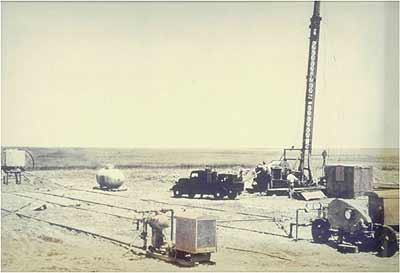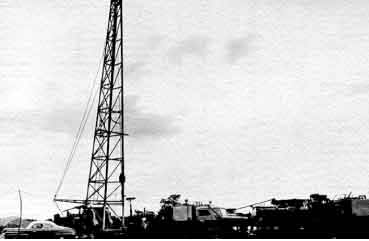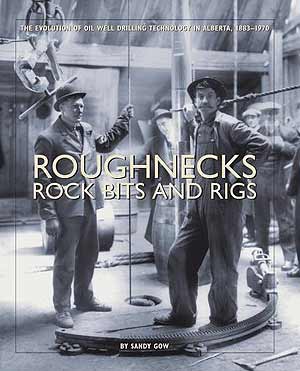Hydraulic Fracturing: History of an Enduring Technology
Publication Type:
Web ArticleSource:
Journal of Petroleum Technology (JPT) Online (2010)URL:
http://www.jptonline.org/index.php?id=481Keywords:
backgroundNotes:
Fig. 1—In 1947, Stanolind Oil conducted the first experimental fracturing in the Hugoton field located in southwestern Kansas. The treatment utilized napalm (gelled gasoline) and sand from the Arkansas River.
Since Stanolind Oil introduced hydraulic fracturing in 1949, close to 2.5 million fracture treatments have been performed worldwide. Some believe that approximately 60% of all wells drilled today are fractured. Fracture stimulation not only increases the production rate, but it is credited with adding to reserves—9 billion bbl of oil and more than 700 Tscf of gas added since 1949 to US reserves alone—which otherwise would have been uneconomical to develop.
In addition, through accelerating production, net present value of reserves has increased. Fracturing can be traced to the 1860s, when liquid (and later, solidified) nitroglycerin (NG) was used to stimulate shallow, hard rock wells in Pennsylvania, New York, Kentucky, and West Virginia. Although extremely hazardous, and often used illegally, NG was spectacularly successful for oil well “shooting.” The object of shooting a well was to break up, or rubblize, the oil-bearing formation to increase both initial flow and ultimate recovery of oil. This same fracturing principle was soon applied with equal effectiveness to water and gas wells.
In the 1930s, the idea of injecting a nonexplosive fluid (acid) into the ground to stimulate a well began to be tried. The “pressure parting” phenomenon was recognized in well-acidizing operations as a means of creating a fracture that would not close completely because of acid etching. This would leave a flow channel to the well and enhance productivity. The phenomenon was confirmed in the field, not only with acid treatments, but also during water injection and squeeze-cementing operations.
But it was not until Floyd Farris of Stanolind Oil and Gas Corporation (Amoco) performed an in-depth study to establish a relationship between observed well performance and treatment pressures that “formation breakdown” during acidizing, water injection, and squeeze cementing became better understood. From this work, Farris conceived the idea of hydraulically fracturing a formation to enhance production from oil and gas wells.
Fig. 2—On 17 March, 1949, Halliburton conducted the first two commercial fracturing treatments in Stephens County, Oklahoma, and Archer County, Texas.
See: Carl T. Montgomery and Michael B. Smith. "Hydraulic Fracturing: History of an Enduring Technology." Journal of Petroleum Technology (JPT). 2010. (PDF 2.1 MB)
At the 2006 SPE Annual Technical Conference and Exhibition (ATCE), SPE honored nine pioneers of the hydraulic fracturing industry as Legends of Hydraulic Fracturing. Claude E. Cooke Jr., Francis E. Dollarhide, Jacques L. Elbel, C. Robert Fast, Robert R. Hannah, Larry J. Harrington, Thomas K. Perkins, Mike Prats, and H.K. van Poollen were recognized as instrumental in developing new technologies and contributing to the advancement of the field through their roles as researchers, consultants, instructors, and authors of groundbreaking journal articles.
This CD includes more than 150 papers published by these industry legends; it also includes an overview of the history of hydraulic fracturing, along with personal reflections from a number of the Legends and their colleagues.
Hydrafrac (1946)
See: Search for hydrafrac on Google Scholar.
See: Gow, Sandy, and Bonar Alexander Gow. Roughnecks, rock bits and rigs: the evolution of oil well drilling technology in Alberta, 1883-1970. University of Calgary Press, 2005. Web.
This book is a comprehensive study of the evolution of the component aspects of drilling technology in Alberta, from the evolution of power sources and drill bit designs to the composition of drilling muds and the use of fishing tools. Included are explanations of the costs and risks of oil well drilling and of the larger issue of industrial technology -- how it evolves and under what conditions. The author draws extensively from original source material such as interviews, photographs, and appendices from both the Glenbow Archives and the Devon-Leduc Petroleum Hall of Fame and Interpretive Centre.
The Stanolind patent (1946), p. 268, was the first patent issued for hydraulic fracturing. You may preview this page by clicking on the snippet in the link I've provided.
See: George C. Howard. "Well Completion Process." Stanolind Oil and Gas Company. Tulsa, OK. June 29, 1949. U.S. Patent number: 2667224, Filing date: Jun 29, 1949, Issue date: Jan 1954.
See also: Erle P. Halliburton. "Method and Apparatus for Drilling Wells, Such As Oil Wells." New Wilson, OK. U.S. Patent number: 1703234, Filing date: Nov 4, 1920, Issue date: Feb 1929.
See: Google Labs Books Ngram Viewer of the historical usage of the term "hydraulic fracturing". Try the word frack or fracking.










